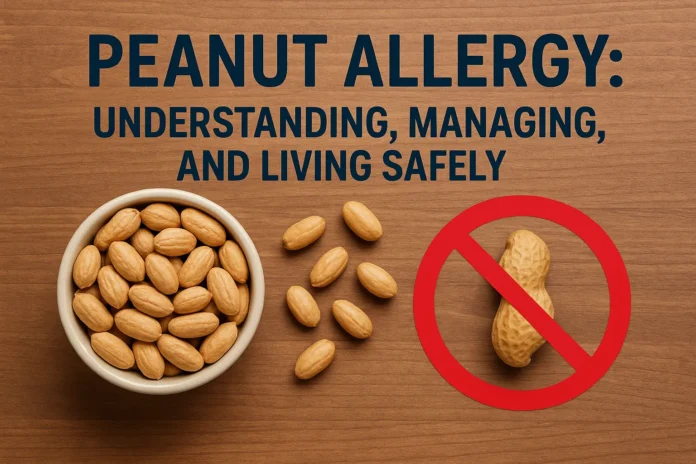Peanut allergy is one of the most common and potentially severe food allergies, affecting millions worldwide. For individuals with this allergy, even a tiny amount of peanut can trigger a life-threatening reaction, making vigilance and understanding paramount.
What is Peanut Allergy?
A peanut allergy occurs when the body’s immune system mistakenly identifies proteins in peanuts as harmful. In response, it produces antibodies that trigger an allergic reaction upon exposure. This is a true IgE-mediated food allergy, meaning the immune system releases histamine and other chemicals that cause a range of symptoms.
Symptoms of a Peanut Allergy Reaction
Symptoms can vary in severity and may appear within minutes to a few hours after exposure. They can affect multiple body systems and include:
- Skin: Hives, redness, swelling (angioedema), itching, eczema flare-ups.
- Respiratory: Wheezing, shortness of breath, coughing, nasal congestion, runny nose, difficulty breathing.
- Gastrointestinal: Nausea, vomiting, abdominal pain, diarrhea.
- Cardiovascular: Drop in blood pressure, dizziness, lightheadedness, faintness, rapid pulse.
- Other: Swelling of the lips, face, tongue, or throat, a tingling sensation in the mouth, a sense of impending doom.
The most severe reaction is anaphylaxis, a life-threatening systemic allergic reaction that can involve multiple organs and requires immediate medical attention. Symptoms of anaphylaxis can include severe breathing difficulties, a sudden drop in blood pressure, loss of consciousness, and shock.
Diagnosis
Diagnosing peanut allergy typically involves:
- Medical History: A detailed account of symptoms after consuming peanuts.
- Skin Prick Test: Small amounts of peanut extract are pricked onto the skin; a raised welt indicates a possible allergy.
- Blood Test (IgE RAST): Measures the amount of IgE antibodies to peanut proteins in the blood.
- Oral Food Challenge (under medical supervision): This is the “gold standard” but is only performed in a medical setting due to the risk of severe reactions. Small, increasing amounts of peanut are given to the patient to observe for a reaction.
Management and Living Safely
Currently, there is no cure for peanut allergy, but it can be effectively managed through strict avoidance and preparedness.
- Strict Avoidance: This is the cornerstone of management.
- Read Food Labels Carefully: Always check ingredient lists for peanuts and peanut-derived products (e.g., peanut butter, peanut oil, groundnuts, mixed nuts). Be aware of “may contain” or “processed in a facility with peanuts” warnings, which indicate a risk of cross-contamination.
- Communicate Allergies: Inform restaurant staff, friends, family, and school personnel about the allergy.
- Be Cautious with Cross-Contamination: Peanuts can easily transfer from surfaces, utensils, or shared cooking equipment.
- Educate Children: Teach children with peanut allergy to never accept food from others and to always ask an adult if food is safe.
- Travel Safely: Research airlines and hotels regarding their allergy policies. Carry allergy cards in multiple languages.
- Emergency Preparedness:
- Carry an Epinephrine Auto-Injector (EpiPen, Auvi-Q, etc.): This is the first-line treatment for anaphylaxis. Individuals with peanut allergy should always carry two auto-injectors and know how to use them.
- Develop an Allergy Action Plan: Work with your doctor to create a personalized plan outlining steps to take in case of an allergic reaction. This plan should be shared with caregivers, schools, and anyone who regularly interacts with the individual.
- Wear Medical Identification: A medical alert bracelet or necklace can inform emergency responders of the allergy.
Emerging Treatments
While avoidance is key, research is ongoing for potential treatments:
- Oral Immunotherapy (OIT): This involves consuming tiny, increasing amounts of peanut protein under strict medical supervision to desensitize the immune system. While not a cure, OIT aims to raise the threshold of peanut an individual can tolerate, offering some protection against accidental exposure.
- Newer Biologics: Some biologic medications are being investigated for their role in modulating the immune response in food allergies.
Checkout Is Cetirizine Safe to Consume? A Comprehensive Guide to This Popular Antihistamine
Living with Peanut Allergy
Living with peanut allergy requires constant vigilance, but with proper education and management, individuals can lead full and active lives. Connecting with support groups and advocacy organizations can provide valuable resources and a sense of community. By prioritizing safety, communication, and preparedness, the risks associated with peanut allergy can be significantly mitigated.
Sources
- American Academy of Allergy, Asthma & Immunology (AAAAI). Peanut Allergy. Available at: https://www.aaaai.org/tools-for-the-public/conditions-a-to-z/allergies/food-allergy/peanut-allergy (Accessed June 10, 2025).
- Mayo Clinic. Peanut Allergy. Available at: https://www.mayoclinic.org/diseases-conditions/peanut-allergy/symptoms-causes/syc-20376175 (Accessed June 10, 2025).
- Food Allergy Research & Education (FARE). Peanut Allergy. Available at: https://www.foodallergy.org/life-with-food-allergies/food-allergy-essentials/types-food-allergy/peanut-allergy (Accessed June 10, 2025).


